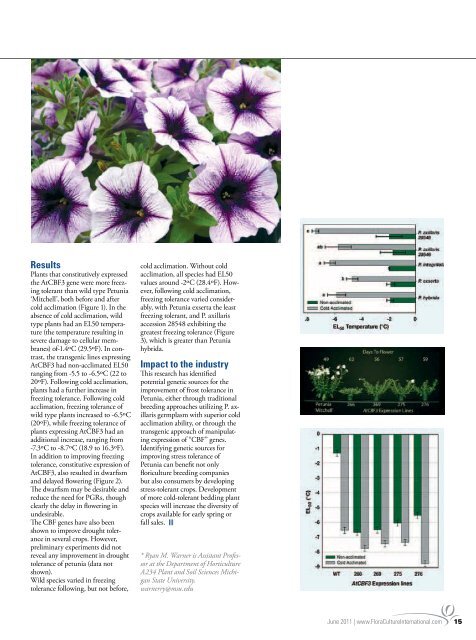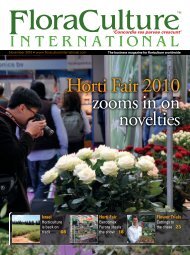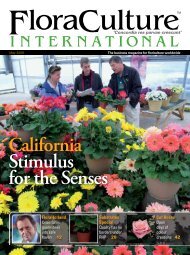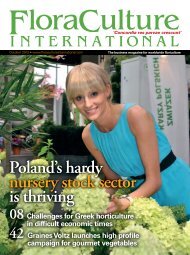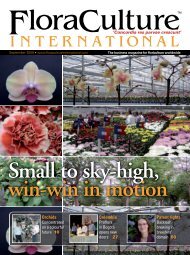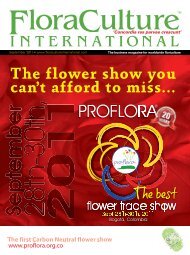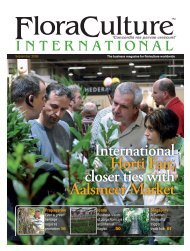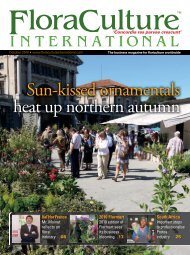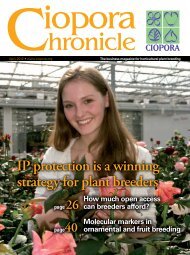12 A sea of flowers at 2011 Pack Trials - Floraculture International
12 A sea of flowers at 2011 Pack Trials - Floraculture International
12 A sea of flowers at 2011 Pack Trials - Floraculture International
Create successful ePaper yourself
Turn your PDF publications into a flip-book with our unique Google optimized e-Paper software.
Results<br />
Plants th<strong>at</strong> constitutively expressed<br />
the AtCBF3 gene were more freezing<br />
tolerant than wild type Petunia<br />
‘Mitchell’, both before and after<br />
cold acclim<strong>at</strong>ion (Figure 1). In the<br />
absence <strong>of</strong> cold acclim<strong>at</strong>ion, wild<br />
type plants had an EL50 temper<strong>at</strong>ure<br />
(the temper<strong>at</strong>ure resulting in<br />
severe damage to cellular membranes)<br />
<strong>of</strong>-1.4ºC (29.5ºF). In contrast,<br />
the transgenic lines expressing<br />
AtCBF3 had non-acclim<strong>at</strong>ed EL50<br />
ranging from -5.5 to -6.5ºC (22 to<br />
20ºF). Following cold acclim<strong>at</strong>ion,<br />
plants had a further increase in<br />
freezing tolerance. Following cold<br />
acclim<strong>at</strong>ion, freezing tolerance <strong>of</strong><br />
wild type plants increased to -6.5ºC<br />
(20ºF), while freezing tolerance <strong>of</strong><br />
plants expressing AtCBF3 had an<br />
additional increase, ranging from<br />
-7.3ºC to -8.7ºC (18.9 to 16.3ºF).<br />
In addition to improving freezing<br />
tolerance, constitutive expression <strong>of</strong><br />
AtCBF3, also resulted in dwarfism<br />
and delayed flowering (Figure 2).<br />
The dwarfism may be desirable and<br />
reduce the need for PGRs, though<br />
clearly the delay in flowering in<br />
undesirable.<br />
The CBF genes have also been<br />
shown to improve drought tolerance<br />
in several crops. However,<br />
preliminary experiments did not<br />
reveal any improvement in drought<br />
tolerance <strong>of</strong> petunia (d<strong>at</strong>a not<br />
shown).<br />
Wild species varied in freezing<br />
tolerance following, but not before,<br />
cold acclim<strong>at</strong>ion. Without cold<br />
acclim<strong>at</strong>ion, all species had EL50<br />
values around -2ºC (28.4ºF). However,<br />
following cold acclim<strong>at</strong>ion,<br />
freezing tolerance varied considerably,<br />
with Petunia exserta the least<br />
freezing tolerant, and P. axillaris<br />
accession 28548 exhibiting the<br />
gre<strong>at</strong>est freezing tolerance (Figure<br />
3), which is gre<strong>at</strong>er than Petunia<br />
hybrida.<br />
Impact to the industry<br />
This re<strong>sea</strong>rch has identified<br />
potential genetic sources for the<br />
improvement <strong>of</strong> frost tolerance in<br />
Petunia, either through traditional<br />
breeding approaches utilizing P. axillaris<br />
germplasm with superior cold<br />
acclim<strong>at</strong>ion ability, or through the<br />
transgenic approach <strong>of</strong> manipul<strong>at</strong>ing<br />
expression <strong>of</strong> “CBF” genes.<br />
Identifying genetic sources for<br />
improving stress tolerance <strong>of</strong><br />
Petunia can benefit not only<br />
floriculture breeding companies<br />
but also consumers by developing<br />
stress-tolerant crops. Development<br />
<strong>of</strong> more cold-tolerant bedding plant<br />
species will increase the diversity <strong>of</strong><br />
crops available for early spring or<br />
fall sales. |||<br />
* Ryan M. Warner is Assistant Pr<strong>of</strong>essor<br />
<strong>at</strong> the Department <strong>of</strong> Horticulture<br />
A234 Plant and Soil Sciences Michigan<br />
St<strong>at</strong>e University.<br />
warnerry@msu.edu<br />
June <strong>2011</strong> | www.FloraCultureIntern<strong>at</strong>ional.com 15


